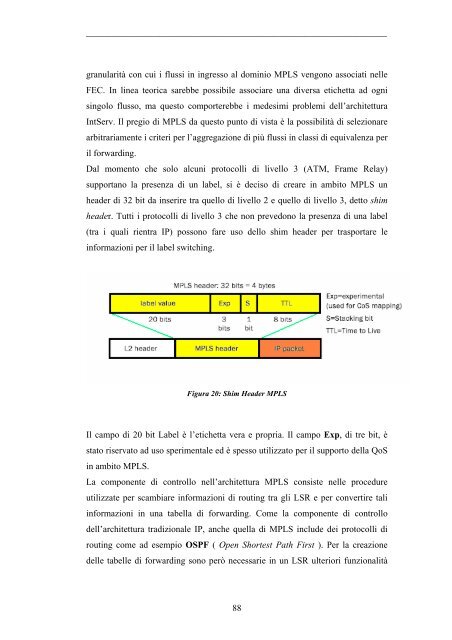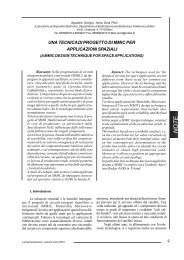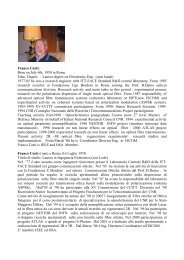Test bed per la valutazione della Qualità del Servizio in reti ottiche ...
Test bed per la valutazione della Qualità del Servizio in reti ottiche ...
Test bed per la valutazione della Qualità del Servizio in reti ottiche ...
You also want an ePaper? Increase the reach of your titles
YUMPU automatically turns print PDFs into web optimized ePapers that Google loves.
__________________________________________________________________<br />
granu<strong>la</strong>rità con cui i flussi <strong>in</strong> <strong>in</strong>gresso al dom<strong>in</strong>io MPLS vengono associati nelle<br />
FEC. In l<strong>in</strong>ea teorica sarebbe possibile associare una diversa etichetta ad ogni<br />
s<strong>in</strong>golo flusso, ma questo comporterebbe i medesimi problemi <strong>del</strong>l’architettura<br />
IntServ. Il pregio di MPLS da questo punto di vista è <strong>la</strong> possibilità di selezionare<br />
arbitrariamente i criteri <strong>per</strong> l’aggregazione di più flussi <strong>in</strong> c<strong>la</strong>ssi di equivalenza <strong>per</strong><br />
il forward<strong>in</strong>g.<br />
Dal momento che solo alcuni protocolli di livello 3 (ATM, Frame Re<strong>la</strong>y)<br />
supportano <strong>la</strong> presenza di un <strong>la</strong>bel, si è deciso di creare <strong>in</strong> ambito MPLS un<br />
header di 32 bit da <strong>in</strong>serire tra quello di livello 2 e quello di livello 3, detto shim<br />
header. Tutti i protocolli di livello 3 che non prevedono <strong>la</strong> presenza di una <strong>la</strong>bel<br />
(tra i quali rientra IP) possono fare uso <strong>del</strong>lo shim header <strong>per</strong> trasportare le<br />
<strong>in</strong>formazioni <strong>per</strong> il <strong>la</strong>bel switch<strong>in</strong>g.<br />
Figura 20: Shim Header MPLS<br />
Il campo di 20 bit Label è l’etichetta vera e propria. Il campo Exp, di tre bit, è<br />
stato riservato ad uso s<strong>per</strong>imentale ed è spesso utilizzato <strong>per</strong> il supporto <strong>del</strong><strong>la</strong> QoS<br />
<strong>in</strong> ambito MPLS.<br />
La componente di controllo nell’architettura MPLS consiste nelle procedure<br />
utilizzate <strong>per</strong> scambiare <strong>in</strong>formazioni di rout<strong>in</strong>g tra gli LSR e <strong>per</strong> convertire tali<br />
<strong>in</strong>formazioni <strong>in</strong> una tabel<strong>la</strong> di forward<strong>in</strong>g. Come <strong>la</strong> componente di controllo<br />
<strong>del</strong>l’architettura tradizionale IP, anche quel<strong>la</strong> di MPLS <strong>in</strong>clude dei protocolli di<br />
rout<strong>in</strong>g come ad esempio OSPF ( Open Shortest Path First ). Per <strong>la</strong> creazione<br />
<strong>del</strong>le tabelle di forward<strong>in</strong>g sono <strong>per</strong>ò necessarie <strong>in</strong> un LSR ulteriori funzionalità<br />
88
















